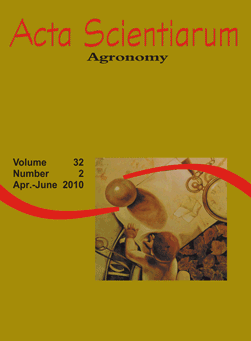<b>Straw management systems influence biomass accumulation and yield of sugarcane crop (var. RB855453)</b> - DOI: 10.4025/actasciagron.v32i2.3703
Keywords:
Growth, sugarcane ratoon, tillering, spittlebug
Abstract
Maintaining sugarcane straw over the soil surface after harvest without burning may damage sugarcane sprouting, tillering and crop yield, mainly in cold climate sites, in addition to contributing to higher levels of spittlebug (Mahanarva fimbriolata) infestations. Therefore, this work was developed with the objective of evaluating the tillering, fresh biomass accumulation and yield of sugarcane ratoon (var. RB855453), as well as the infestation level of M. fimbriolata, when the crop was submitted to three different straw management systems: (i.) straw in total area; (ii.) uncovered rows and (iii.) accumulating the straw of three rows in one interrow. As a result of experimental rigor provided by the Tukey test and the size and representativeness of each plot (2700 m²), it was possible to conclude that keeping sugarcane straw over the soil in total area, after harvest without burning, reduced ratoon development, presenting lower yield and tiller biomass. Straw accumulation of three rows in one interrow did not contribute to the number of tillers; however, it promoted higher biomass of tillers and consequently higher yield, without difference for the management of uncovered rows. Lower infestations of M. fimbriolata were identified in the treatment with uncovered rows; however, the control level was not reached and thus, the entomological damages must not have contributed to the lower crop yield under straw in total area.Downloads
Download data is not yet available.
Published
2010-04-27
How to Cite
Campos, L. H. F. de, Carvalho, S. J. P. de, Christoffoleti, P. J., Fortes, C., & Silva, J. S. da. (2010). <b>Straw management systems influence biomass accumulation and yield of sugarcane crop (var. RB855453)</b> - DOI: 10.4025/actasciagron.v32i2.3703. Acta Scientiarum. Agronomy, 32(2), 345-350. https://doi.org/10.4025/actasciagron.v32i2.3703
Issue
Section
Crop Production
DECLARATION OF ORIGINALITY AND COPYRIGHTS
I Declare that current article is original and has not been submitted for publication, in part or in whole, to any other national or international journal.
The copyrights belong exclusively to the authors. Published content is licensed under Creative Commons Attribution 4.0 (CC BY 4.0) guidelines, which allows sharing (copy and distribution of the material in any medium or format) and adaptation (remix, transform, and build upon the material) for any purpose, even commercially, under the terms of attribution.
2.0
2019CiteScore
60th percentile
Powered by 

2.0
2019CiteScore
60th percentile
Powered by 



















































